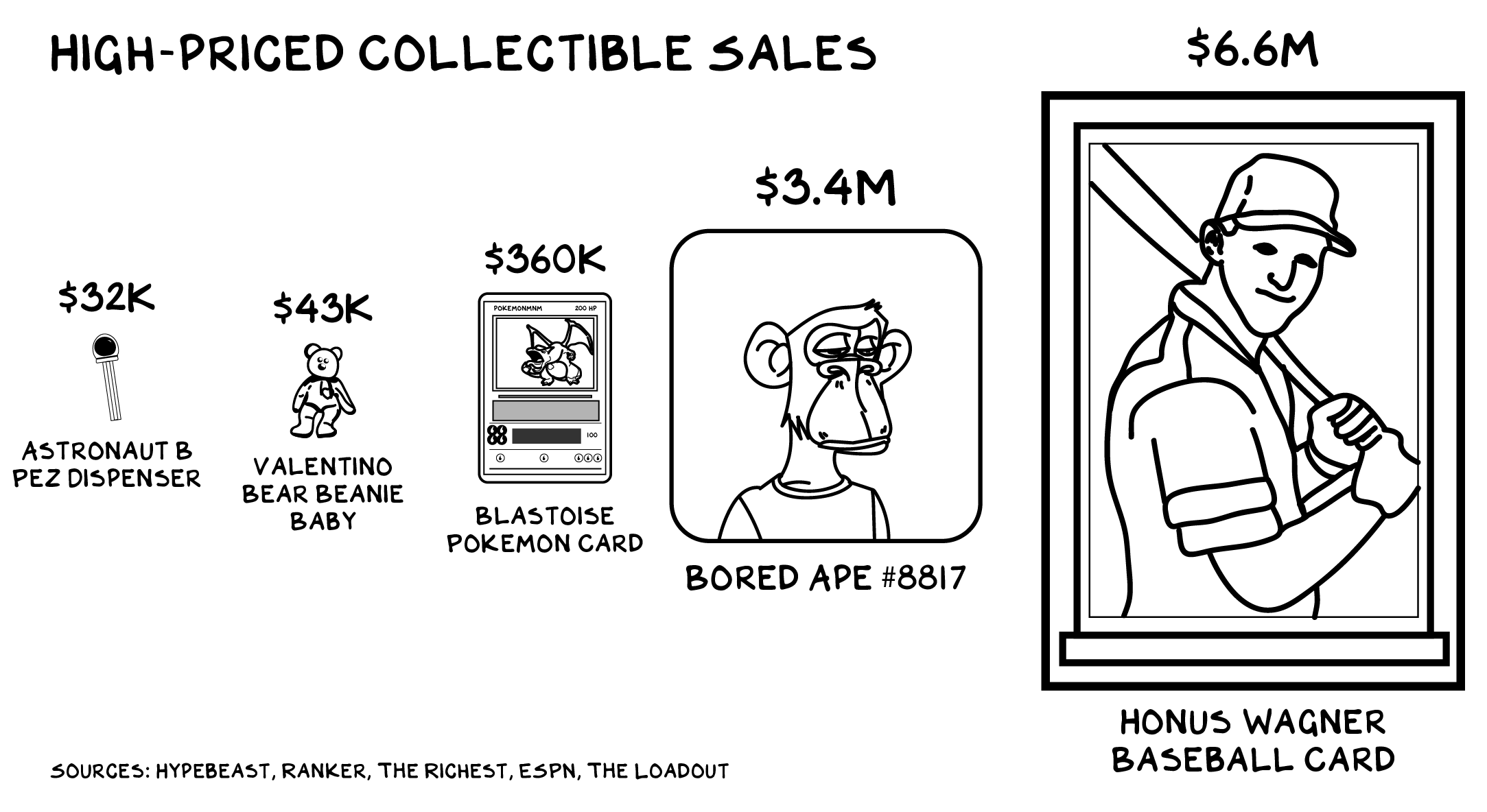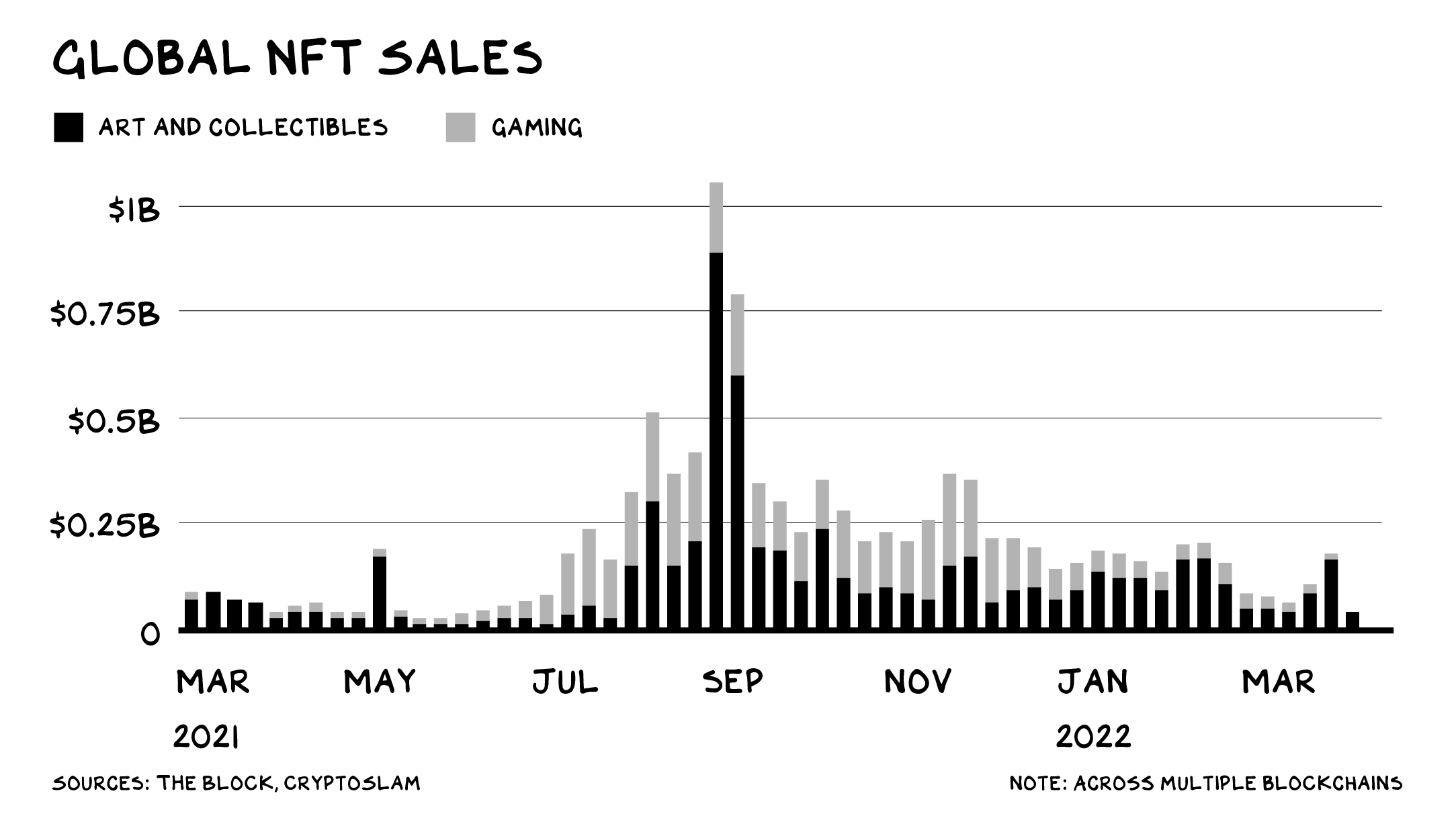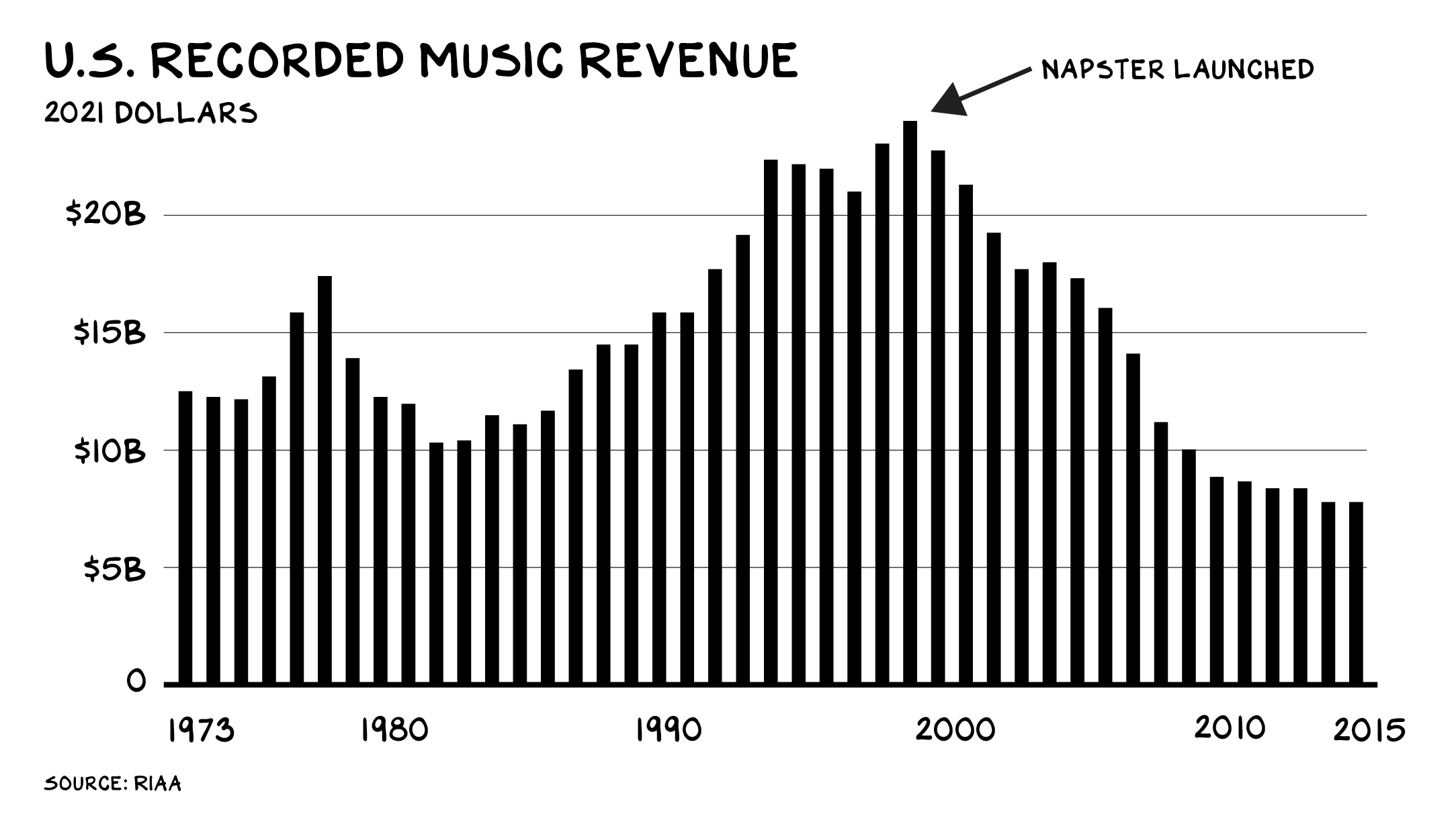
NFT Unpack
Last week, Mark Zuckerberg announced NFTs are coming to Instagram. What does that … mean? The announcement was a word salad of platitudes, so we don’t know how the Zuck will bolt this latest thing onto his Frankenstein product structure. The good money is it won’t work — Meta is one of the best acquirers in history, and one of the least innovative. The broader, and more interesting, question is the half-life of NFTs.
As we ended 2021, NFTs were white-hot. Forty-one billion dollars hot, and everywhere. Twitter beat Zuckerberg to the NFT punch, letting tweeters use an NFT as their profile picture, Spotify is hiring for NFTs, and brands from Budweiser to Louis Vuitton are producing them. You can even buy a virtual NFT of the McDonald’s McRib. But there are signs the hype is fading. Trading is down, Google searches are down, scams and frauds are (still) up.

The sun may have passed midday on the hype cycle, but NFTs (or something similar) have real potential to be an unlock for a fundamental aspect of the digital economy.
So … WTF is an NFT? Technobabble aside, it’s similar to the deed to a house. A digital document that identifies one true owner of a digital product. Real estate deeds rely on an ecosystem of paper and electronic records, legal standards, and institutions staffed by experts. It’s worth the expense, as real estate is valuable. NFTs, or non-fungible tokens, are deeds rendered in the world of bits, not atoms. Digitally native, NFTS are (theoretically) lower cost than real estate deeds — thus they’re economically practical for digital items and lower-value property. Deeds … for anything. As private property and ownership are central to capitalism, and economic activity increasingly moves online, NFTs may become central to our economy.
Scarcity and Authenticity
NFTs offer digital commerce something the Internet lacks: scarcity and authenticity. A scarcity mentality is built into us at an instinctual level. Our cravings for sugar and fat (historically scarce) have resulted in an obesity crisis, because our instincts haven’t kept pace with industrial food production. Authenticity’s virtues are practical (we like to know where our food comes from and who we can sue if it makes us sick) and philosophical (if we buy music, is some of the money going to the artist who made it?).
Limited options for credible scarcity and authenticity have rendered digital commerce chaotic. Napster broke the barriers of scarcity that were inherent to physical distribution of music on plastic discs. The pirating of digital goods of all kinds reduces both tech profitability and long-term innovation. Google put the news media into intensive care by reproducing its content (ending scarcity), and Facebook drove another nail in the coffin by de-emphasizing the source (neutering authenticity).

Enter blockchain. Bitcoin became a trillion-dollar asset class because it cracked this code. A dollar bill is worth $1 because only the U.S. Treasury can make it (authenticity) and we trust Uncle Sam to mint a limited number (scarcity). Bitcoin’s “proof-of-work” system likewise ensures scarcity (there will only ever be 21 million bitcoins produced) and authenticity (all are tracked on an immutable public ledger).
NFTs offer the promise of scarcity and authenticity for digital goods. NFTs aren’t the only way to create scarcity and authenticity online — trusted, centralized entities such as banks (and platforms such as Twitter and Apple) do it within their verticals, and blockchain tech is evolving to address myriad environmental and security concerns. So the current implementation of NFTs may not be the best way, or even a good way (many reasons to be skeptical). But they’re … a way. A potentially widespread, inexpensive way to offer credible scarcity and authenticity online, opening up new vistas of digital commerce. Prospectors are rushing in.
Art
The world beyond crypto-obsessives started paying attention to NFTs a year ago, when digital artist Beeple sold an NFT mosaic of his daily digital images, Everydays, at Christie’s for $69 million. No asset class depends more on scarcity and authenticity than art. The Mona Lisa’s value relies on our belief that there’s only one (scarce); plus, we know it was created by da Vinci (authentic).
As deeds do for real estate, a whole industry of galleries, museums, and consultants, along with ancient documents and high-tech gadgets, props up the fine art market. We know this from the failures: A single successful forger, Pei-Shen Qian, formerly of Queens, brought down a 170-year-old art gallery and spawned 10+ lawsuits (and one Alec Baldwin podcast) with his oeuvre of fake Rothkos. NFTs offer a defense against digital forgery. Beeple’s Everydays is authenticated publicly, on the blockchain (and a less cryptic Opensea listing, with legibility brought to you by … centralization). The lower priced the art, the more it requires a scalable platform for establishing scarcity and authenticity.
Bored Ape
Bored Ape Yacht Club — a series of JPEGs of monkeys wearing different outfits — is no more or less risible than any other trend. There are 10,000 of them, each unique, and they’re collectively valued at $3 billion. The floor price for one is $311,000. The company behind les singes ennuyés, Yuga Labs, has consolidated its position as the dominant force in NFT-based collectible bubbles, buying up the NFT brands CryptoPunks (bored dudes) and Meebits (bored avatars) and raising $450 million at a $4 billion valuation.

Is this a JPEG ape bubble? Likely. Collectible bubbles are nothing new. Beanie Babies were individually unique, cartoonish figures produced at low cost and brilliantly marketed. In 1997, eBay sold $500 million worth in a month — 6% of the company’s annual sales. Garbage Pail Kids, Cabbage Patch Dolls, animation cells, POGS, tulips — the list goes on. Some endure, such as vintage baseball cards (outperforming the S&P 500 since 2008). There is a huge market for modestly priced art and un-bubbled collectibles that could benefit from digital scarcity and authenticity. NFTs also offer the potential for creators to collect royalties every time their art is sold in the secondary market, remedying some of the creative economy’s inequities.
How long will Bored Apes remain culturally relevant? Don’t know. They are trees, which live and die. Yet the forest is immortal.
Brands
For brands, scarcity and authenticity is everything. Chanel can sell sunglasses for $500 because they’re scarce and they’re Chanel. In exchange, the customer gets to say “I’m aspirational” without saying “I’m aspirational.” But branding goes beyond signaling wealth. Doc Marten boots say something, and Wrangler and Levi’s say something else. Oatly is not milk, but it is a statement about who you are.
People underestimate the power of brands; it’s a lie we tell ourselves. Branded beer tastes better than non-branded beer. Allergy medication is more effective after you watch branded advertisements. Labradoodle vs. Labrador, Star Wars vs. Dragon Ball, iOS vs. Android, NYU vs. Columbia — we are a tribal species, and we sort ourselves with logos. Logos that we insist are “authentic,” despite the availability of knock-offs. A robust ecosystem of intellectual property laws and institutions ensures a brand’s owners control scarcity, and NFTs augment that system in the digital economy.
Many companies are catching on to this in their own socially stunted, corporate, Zuckerbergian way. People want to show up to the Miller Lite metaverse tavern no more than they want to follow Miller Lite’s Instagram page. There’s no doubt that much of the fullness brands give to physical life is missing online.
Belongings
Every morning I put on a Panerai watch to signal my masculinity and success. I haven’t wound it in 10 years. Online I have something even more scarce: A Twitter blue check. The blue check is a digital Panerai (sort of): scarce and authentic, it signals that if you mate with me your kids are more likely to survive than if you couple with someone missing the blue check.
One of the keys to NFTs will be portability across mediums. A Twitter blue check can’t exist on Instagram, but the NFT equivalent of a Twitter blue check can — and deliver credible authenticity, thanks to that NFT deed. This is the metaverse vision of interoperability that could help make digital belongings feel similar to physical belongings.
Digital belongings exist on the internet, but there aren’t that many types of them. On Fortnite you can acquire guns and outfits. On Reddit you gain badges. Point is: There’s a lot of stuff on the internet, but there isn’t much stuff that’s yours.
Now ask yourself: How much physical stuff is yours? Think of every item in your house: books, paintings, photos, CDs, heirlooms, trophies, etc. What’s the market value of all that? As our lives move further online, so will our stuff, and we’ll need some sort of infrastructure that allows us to own it.
Money Changes Everything
I’m a capitalist and generally think that functioning markets improve lives. Bringing credible scarcity and authenticity to digital markets is a net positive — but the key word there is “net.” The flood of interest in NFTs has predictably resulted in scams and exploits. The market has cooled off recently, with the top corresponding pretty closely to former First Lady Melania Trump’s NFT scam. (She bought her own NFT through shell accounts to create false signals re the value.) When I interviewed Mark Cuban (owner of the Dallas Mavericks), he raised concerns about sports team NFTs injecting a money-making incentive between the fans and the team, replacing the emotional bond they feel with the team and players with the anxiety of a Robinhood day trader sweating a position.
Scarcity and authenticity are powerful, and not always forces for good. Our instinctual craving for scarce sugar and fat has produced an obesity crisis, but we aren’t going to throw out the industrial food system and live off the land. Amidst the scams and bubbles, credible scarcity and authenticity will unlock real value in digital markets.
In sum, Madame First Lady Trump,
Learn the damn language: scarcity and authenticity.
Life is so rich,

P.S. Section4 membership now comes with unlimited sprints. Yes, you read that right — unlimited two-week business courses at a highly affordable price. Sign up now.


I think I’m going to spend more time in nature and with things that are not digital.
Here’s a relevant quote: “We must remember that nothing in this world really belongs to us. At best we are merely borrowers”. – Christopher Isherwood.
I have to agree with Scott that “true ownership of a digital asset” has enormous implications. In my world, people want digital credentials of their education, skills, experience, projects, and also their digital art. I’m in the publishing business and we have to give away 75% of our content to get people to buy a subscription. Imagine if the NYT charged a penny every time you read an article, and you could buy movie tickets, event seats, and everything else this way. It’s very disruptive to many incumbent businesses.
NFTs are not capitalism – they are where capitalists play just like art collection. Drop the N and now you have a transitional form of exchange for fractional ownership of any real asset…Fungible Tokens.
Panerai? Gotta upgrade your game; too ubiquitous.
Maybe a watch brand named “Ubiquitous” is the answer.
It really seems that you missed the plot. I was really hoping you’d be more critical and direct about the underlying scams. The ones that played with Beeble’s art as a way to use scarcity to enrich one other man: Vignesh Sundaresan. It’s all being used to scam and deceive. After 13 years of hype, the use case is minimal and the cost to our planet, let alone the mental health of society is terrible. It’s mostly cryptobros and scams. The Greater Fool grift.
NFTs or expensive watches/handbags. All subs for common sense or a distraction from your physical limitations.
Sad that ‘Marketing’ has discovered this pot of gold.
So which blockchain implementation is an “NFT” built on? I assume more than one? If that technology goes away so does your NFT and your money.
Ether
What do you mean if the technology goes away ? decentralized blockchain is not going away… sorry ser
The only way for the blockchain to stop 🛑 is for every single PC/Net Connected device to cease from existence or just stop running the software all together. As long as decentulization of Blockchain technology and other tech industries exist, so will any old, new, or newneeww blockchains and respective Coins/Tokens/NFTs. BTC ftw.
NFTs are live on ETHEREUM, POLYGON, BSC, SOLANA, AVALANCHE, POLKADOT, and many more blockchains; with new forks and implementations and upgrades constantly being deployed. This stuff is going nowhere. Although, remember, nothing is impossible – just highly Improbable. And a fun fact for you: we are all still in the “baby faze” or the new wild west. So the mere fact that you are curious and asking great questions, suggests that in maybe another 10 years if you invest now, you’ll be one of the most wealthy individuals on the planet/planetsss.
Missing here: in many cases, the “digital deed” can be far more than just rights to an image. It’s can also be a ticket to digital and physical experiences, a loyalty program unlocking new rewards over time, an item with attributes unlocking differentiated gaming/social experiences, etc.
One note: NFTs do not confirm the authenticity of the artwork sold in the NFT, they only confirm the authenticity of the NFT itself.
These are two very different and very misunderstood things. This confusion is actually making fraud and forgery easier – in essence making it easy for multiple Pei-Shen Qians.
NFTs record who created the NFT, an NFT is just a record of actions such as sell, transfer, hold, etc….. which reference the item as a token.
NFTs trust and assumes that the person creating the NFT has the right to sell it. This is not always the case – there are 100s millions of dollars of Digital NFT Art that have been sold that are in copyright infringement. Sometimes it is on purpose as with Pei-Shen Qian and sometimes it is by honest mistake.
In a real-world example, Person A takes a photo of cityscape of private property but is publically viewable and sells it as an NFT. Over 85% of the photo (the focus of the photo) is a mural.
The artist who created the mural later sold both a digital photo and the actual mural as one NFT.
Which NFT is authentic – the artist can claim the COA (certificate of authenticity) that they created the work.
The photographer can prove that they minted the NFT first.
The mural is publicly viewable but on private property.
When the mural is sold in real life what are they buying? Not the wall but the mural? If a person buys the building the wall supports do they have the rights mint a new NFT or is the value of the NFT subtracted from the sale of the property?
Dont get me wrong – NFTs have incredible potential and applications – Digital Art was a bad one for it’s coming out party. For Digital Art it doesn’t solve a problem, it does not make for a better experience and it does not remove friction or barriers.
It actually creates more problems, confuses the experiences, and creates more friction and barriers.
Food for thought right here – thank you
This was great! It is rare to see this view and not be blinded by all the hype and scams that surrounds NFTs. It is behind the curtains where the true value lies.
unless behind the curtains is the wizard of Oz?
Speaking of scams, you should check out the censorship of Hunter Biden’s laptop and its contents. Perhaps his anonymous art collectors can buy NFTs of his crack smoking photos.
“NYU vs. Columbia” – funny stuff.
In the digital world, scarcity is artificial. The whole point of 0s and 1s is fidelity reproduction. In pharma, like making a movie, up front costs dominate. Copying is low-cost, but still a cost. With digital, that cost drops to zero. Zero is too low to spur innovation, but much higher than marginal cost signifies rent extraction or market power.
The whole initial value, rather, dream of the Internet was democratization. NFTs are about scarcity – the decentralized vs. centralized is a side distraction. As many people point out, crypto hasn’t made finance more level – it’s still a small subset of (mostly elite males) that’s gotten ridiculously rich.
Should it not be : madame former first-lady ?
Authenticity of Picasso might matter, depending on what it is used for (status, museum wall vs coffee mug) because any copy of it is imperfect. But with the NFT the copy IS perfect. Why does scarcity of the original matter? It’s all in the mind of the beholder, just like Tom Brady’s “last football”. Once the sentiment changes, and it will when some other new hype rolls in, the value of NFT will plummet along with their liquidity. Just one person’s opinion.
Hi Scott. You’re making a classic mistake of thinking about NFTs here. You say “Technobabble aside, it’s similar to the deed to a house. A digital document that identifies one true owner of a digital product.” But an NFT *does not* show that. The NFT includes no transfer of the copyright or ownership of the actual image, music, or intellectual property attached. What you are buying is a piece of cryptocurrency with a *copy* of the art *attached*. The analogy is not buying the deed to a house, but rather buying a Trapper Keeper with a print of a Lisa Frank painting on it. There’s nothing in the NFT that gives you any ownership interest in the art, nor a reason the NFT exchange couldn’t just swap the art for some other art or no art on you at a later date with no warning. This is like buying a coin that was reshaped in one of those carnival machine presses, no more and no less.
I actually think you’re doing his argument a disservice. Scott has written extensively about Web 3 in previous pieces that you should know that he’s steel-manning here (he alludes to this, in this article, when he mentions that there’s lots that’s wrong with NFTs).
In other words, he’s talking about what NFTs *can* be. Infact this entire piece is rather futuristic, even.
NFTs as a well-designed abstraction of digital ownership, with guardrails for scarcity and authenticity would inject these non-native but highly valuable characteristics into the world of bits.
I think he just obviously pointed out that NFT’s are nothing like a deed to your house, which is true. Also, I looked on his Twitter page and couldn’t find anything about this “blue check”?!
I hope he didn’t pay too much for it,
The sales chart shows you all you need to know about NFTs. They are a scam to consumers, and a cheap high margin get rich quick profit lever for producers. It has no legs.
You call out Melania for her ‘scam’. That is damn near the majority of money in the NFT business. People buying their own NFTs to set market prices, inject false liquidity in the market, or – in other cases – use them to launder money.
There is no future here. Easy to see why one would get caught up in the hype last fall, but to still think there is a market for NFTs (anytime soon at least) is just good old fashioned bag holding.
Lazy and smug take.
4M+ Americans have bought or sold an NFT, and you’re convinced the “damn near majority” are bad actors? How would you possibly know that?
Scott nailed the larger trend here:
“One of the keys to NFTs will be portability across mediums. A Twitter blue check can’t exist on Instagram, but the NFT equivalent of a Twitter blue check can — and deliver credible authenticity, thanks to that NFT deed. This is the metaverse vision of interoperability that could help make digital belongings feel similar to physical belongings.
Digital belongings exist on the internet, but there aren’t that many types of them. On Fortnite you can acquire guns and outfits. On Reddit you gain badges. Point is: There’s a lot of stuff on the internet, but there isn’t much stuff that’s yours.”
“that could help make digital belongings feel similar to physical belongings.”
This is the part that I find really interesting … and also out of touch.
I’ve never understood or experience the appeal of this. But I also don’t understand the appeal of what a lot of people buy, nor would some understand why I buy the things I do.
What I’m curious about is that, even with the huge numbers in play here, how mainstream will this get?
Cryptocurrency competes with fiat currency (at least it was supposed to?), so the potential disruption is, of course, enormous because everyone uses currency every day.
But how many people collect things or value digital assets that can be replicated an infinite amount of times? Yes, real physical art can and is be faked, but the work to fake an oil painting is almost infinitely higher than replicating a digital print.
4M+ Americans being in the NFT marketplace doesn’t seem small to me. What do you think about the future of NFTs?
Er .. makes me *feel” out of touch.
How dare you, Scott. That’s Charizard, not Blastoise.
I’m glad I’m not the only one who noticed
Thank you!! I came here to yell about that lol
An incredible clear explanation of the mysteries. Well done!
Thanks Scott–a remarkable run down with a bit of witty snark, well done, great read!